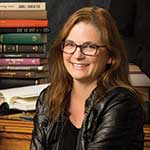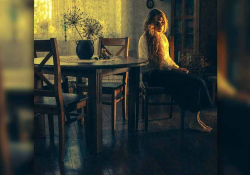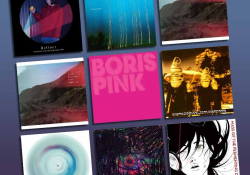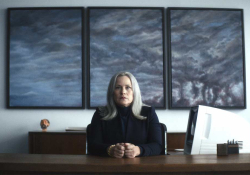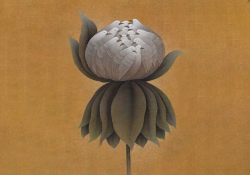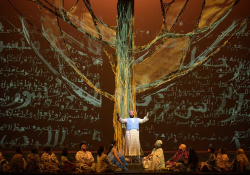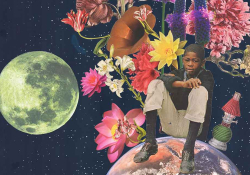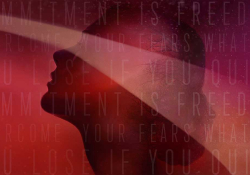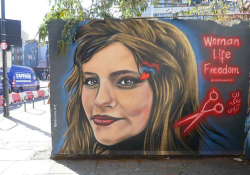Art as a “Catalyst for Conversations”: A Conversation with Philbrook Curator Susan Green
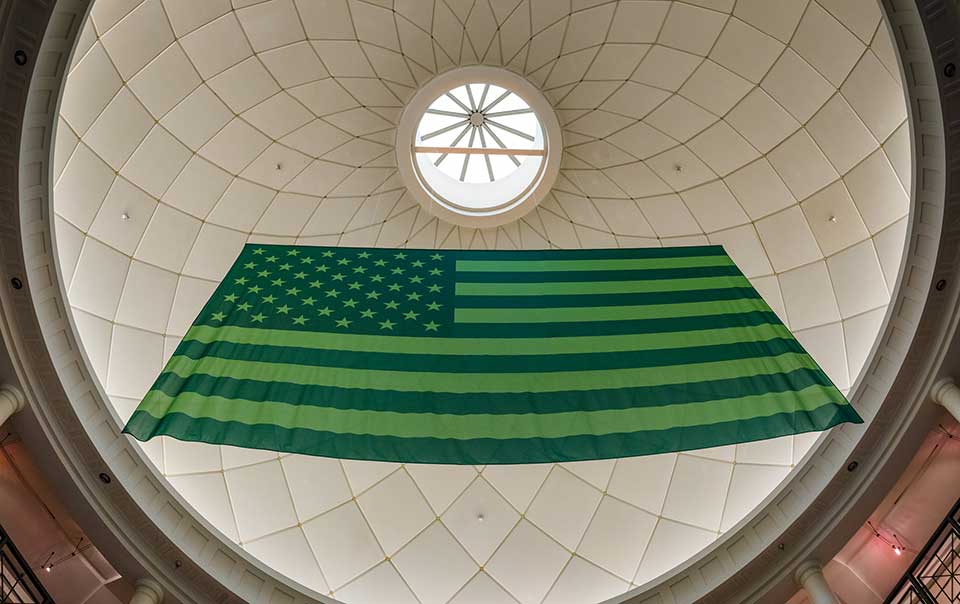
The Philbrook Museum of Art in Tulsa, Oklahoma, has two exhibits this summer that connect with literature. The first, From the Limitations of Now, borrows its title from Oklahoma-born Ralph Ellison, author of The Invisible Man. The second, Dalí’s Alice in Wonderland, explores Salvador Dalí as illustrator of Lewis Carroll’s Alice’s Adventures in Wonderland. A third exhibit, Views of Greenwood, explores the Tulsa neighborhood that was all but destroyed in the 1921 Tulsa Race Massacre, the centennial of which is this year. WLT’s Spring 2021 issue cover feature is devoted to reflections on that centennial.
Here, WLT’s culture editor visits with Philbrook curator Susan Green about these exhibits and her artistic inspirations.
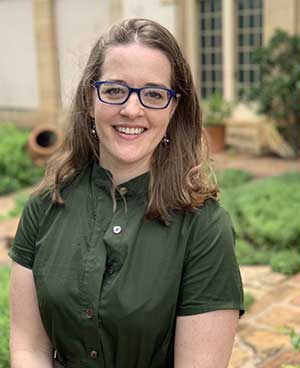 Michelle Johnson: As the Marcia Manhart Endowed Associate Curator for Contemporary Art & Design, what is your role at Philbrook?
Michelle Johnson: As the Marcia Manhart Endowed Associate Curator for Contemporary Art & Design, what is your role at Philbrook?
Susan Green: I am incredibly lucky to work as part of a dedicated curatorial team that develops exhibitions, installations, and programming for the public. Specifically, I oversee the decorative arts and design collection, the historic Villa Philbrook, and the museum’s special collections and archive, and each Philbrook curator works across our collections to build connections, discover stories, and ask questions for and with our visitors.
Johnson: If you were, say, a novelist, we’d ask you if there was a book that sparked your desire to write. Perhaps we should ask you if there is a particular work of art that set you on your path in the art world?
Green: There are so many works of art that have hooked me—drawn my curiosity, intellect, and heart, or hit me on a gut level. I grew up in a family that took every opportunity to visit any museum, whether vast or small (the small, quirky ones are the best). I suppose the first time I discovered that art is more than the surface of a painting was when I was around five. I was really enjoying reading—looking for and comparing words, and I noticed that the artist’s name and title on the museum label next to a painting was different from what was engraved on an older brass plaque adhered to the painting’s frame. It really bothered me; I thought that the museum had made a mistake. But I began to realize that there could be multiple answers—that someone long ago thought that the painting was made by one artist, but that museum staff, perhaps with more information, had attributed it to someone else. I love that our understanding of artwork changes over time—both with added context and through our own personal experiences.
I love that our understanding of artwork changes over time—both with added context and through our own personal experiences.
Johnson: What is your favorite piece in Philbrook’s permanent collection and why?
Green: Every day I discover a new work or an old favorite grabs me—from the incredible chrome and blue glass 1936 Nocturne radio to a sixteenth-century Spanish portable desk (or vargueño) with delicate enameled plaques that tell the story of St. Ursula. Right now, a favorite work is also a new Philbrook acquisition: Baltimore Barbershop (1970), by Don Thompson, a Tulsa artist. In this photograph of barber David Gardner, Thompson presents the personal experience of a business owner in the Greenwood district of Tulsa who faces the destructive consequences of urban renewal. At the same time, Thompson explores complex relationships of reflections, transparency, and visual as well as physical access.
Johnson: Are there any writers whose writing about art you particularly enjoy? Documentaries you would recommend?
Green: Recently I delighted in the 2019 book A Month in Siena, by Hisham Matar. In what is part memoir and part meditation on art and architecture, Matar explores image and space through evocative and powerful language—transporting the reader to Siena and placing them before thirteenth- through fifteenth-century paintings by artists including Pietro and Ambrogio Lorenzetti (a Crucifixion from ca. 1350 by a follower of the artists is in the Philbrook collection).
There are many incredible documentaries that explore art and creativity. A few films that I might recommend range from Beauty Is Embarrassing, which revels in the irrepressible imagination of Wayne White, to Faces Places and the quiet and deep collaborative friendship of Agnès Varda and JR, to the classic series of films by Albert and David Maysles about the work of Christo and Jeanne-Claude, who came to Philbrook in 2009 for a screening of the documentary The Gates. I truly treasure memories from that evening with the artists.
Johnson: One of your current exhibits, From the Limitations of Now, borrows its title from Oklahoma author Ralph Ellison. Is this from his speech in Oklahoma City, when the Library Commission named a library branch after him? These remarks seem particularly apt for an art museum or other cultural institution as well as a library: “It is no accident that Fascists despise and fear books. They burn libraries. Why? Because the library is a nexus of dreams. The library is a place where we are able to free ourselves from the limitations of today by becoming acquainted with what went on in the past—and thus project ourselves into the future.” How did these words inspire the current exhibit?
Green: My amazing colleague Sara O’Keeffe curated From the Limitations of Now. She definitely drew from that 1975 speech and specifically from the passage you quote, considering the broader context of art and literature. Ellison had returned to his hometown, and in his speech, he recalls the importance of his neighborhood library and the possibilities books offered while he was growing up, even though the branch itself existed within a library system that was then segregated. Each of the living artists in the exhibition read the speech and created work in direct response to those words and the call to understand our present and speculate on visions of a future still yet to be.
Johnson: What are some of the items in the exhibit, and how do they connect with the theme?
Green: The first artwork that visitors encounter when they step through the doors of Philbrook is a work by Adrian Aguilera and Betelhem Makonnen, untitled (a flag for John Lewis or a green screen placeholder for an America that is yet to be) (2020). This vast 12' x 20' American flag in tones of green hangs from the center of the Rotunda dome, and visitors walk beneath the flag to access the galleries and gardens. The work honors the great civil rights organizer Congressman John Lewis and his tireless work toward the democratic ideals of justice, liberty, and equity. The flag suggests that, with continued effort, we can create the country “yet to be”—a place of true liberty. The green tones of the flag serve as a media greenscreen, a place where we can project our ideals, our hopes, and our actions until there is realization of justice.
The exhibition features artwork across media—from film to installation. Many works amplify stories that have been suppressed, and each work engages in our history in different ways. Lonnie Holley has spent his career directly addressing painful chapters of our history and exploring how art can be a tool for healing. Three works are part of the installation: After the Revival (Vox Humana III: The Strength of Music Lives After the Instruments Are Destroyed) (2017), Weighed Down by the Hose (2008), and They Never Saw Our Faces (2021). Tulsa artists are an important part of the exhibition, including photographer Serae Avance, who celebrates powerful and successful Black women in Tulsa through her vibrant, large-scale portraits in the Unity series (2021).
Johnson: How are you seeing visitors interact with the exhibit?
Green: The artwork in From the Limitations of Now stretches across the main level of the museum, and the special exhibition gallery has become a space of action and reflection. It is an active reading room, developed in collaboration with Fulton Street Books & Coffee, and visitors can read justice-focused books from board books to biographies. It is also an art-making and collaborative space. Visitors can create a button that imagines a different world, and once they have finished their own, small work of art, they leave it behind and choose a button that someone else has made before them. It’s a beautiful act of creating, giving, and imagining someone who will come after you.
Johnson: In a second, concurrent exhibit, you’re focusing on the connection between Salvador Dalí and Alice in Wonderland. What is the backstory there? How did Dalí come to this project?
Green: In 1968 and ’69, Salvador Dalí created illustrations for Lewis Carroll’s beloved children’s tale Alice’s Adventures in Wonderland. Maecenas Press – Random House published a limited-edition, large-scale portfolio of the book in 1969. Dalí had provided illustrations for other books previously, including Don Quixote, The Divine Comedy, and Macbeth. Each of these titles had something that intrigued the artist—the same can be said for Alice. As a pioneer of surrealism, Dalí delved into the unconscious mind and played with irrationality, juxtapositions, and dreamlike situations—all themes found within Carroll’s story. Alice’s Adventures in Wonderland is a complex tale of layered realities that explores themes like transformation, shifting identities, overturning conventions, and the illogical and often bewildering experiences of adult life. The story became a perfect conduit for Dalí’s imagination; his images of Wonderland depict a rational world turned upside down.
Dalí’s images of Wonderland depict a rational world turned upside down.
Johnson: How do his illustrations for the book connect with motifs in his own work?
Green: Throughout the illustrations, Dalí plays with these themes of irrationality and transformation and intersperses familiar motifs from his work. For example, in the illustration for “A Mad Tea Party,” the chapter in which Alice encounters the March Hare, Mad Hatter, and Dormouse, Dalí includes a melting clock. His iconic image serves as the absurd characters’ tea table and refers to the Mad Hatter’s watch, perpetually stuck at six o’clock. Here, the clock denotes more than just the passage of time. While inescapable, time has lost all meaning as it droops toward the ground.
Other recurring motifs include keys, crutches, butterflies, and his very depiction of Alice, which appears in each illustration. For Dalí, Alice is a young woman skipping rope across a landscape, an image he used multiple times throughout his career. Here, the rope, thrown above her head, mirrors the shape of a rabbit hole or looking glass—a portal into a realm of strange encounters and curious adventures both for Alice and for us, the viewer and reader.
Johnson: In addition to being an avid reader, I’m a devoted lover of books as objects. Though some might view this as outdated, I’m often reminded that I’m not alone. This exhibit seems particularly designed for people like me who flock to the Morgan Library. Who is it for?
Green: I too love the physicality of books—from the beauty of typefaces to the luxurious texture of the paper, and I think that the resurgence of bookstores and special editions of artist-designed books shows that we are not alone. This spotlight exhibition is for lovers of books, text, and images (as well as absurd and playful stories). The image and text were carefully printed by skilled craftspeople, and the unbound pages are gathered within a portfolio, which was crafted by the French firm Cartonnage Adine founded in 1806 and is a work of art in itself. Each illustration with its facing text has been framed and hangs in chapter order within the gallery, and I think it is fascinating to consider the positioning of the image with the text and how the image both supports the text and provides a window into Dalí’s mind.
The exhibition is also for visitors of all ages—we have loved seeing young children looking closely (magnifying glasses are provided!) to find Alice in each illustration and discover the animals, insects, and creatures that Dalí has imagined. We also have provided a number of editions of Alice’s Adventures in Wonderland to read, each with a different illustrator, so that visitors can compare how varying artists conceive of the wonders of Wonderland.
The exhibition is also for visitors who love our gardens. Our horticulture team took on the adventure of Alice to inspire their planting designs for the summer. Not only did the horticulturists look to Dalí’s colors, textures, and themes, they also were inspired by surreal juxtapositions and playful irrationality, creating garden landscapes that extend the influence of Dalí’s images and Carroll’s text and connect garden with gallery.
Our horticulture team took on the adventure of Alice to inspire their planting designs for the summer.
Johnson: What is something new we’re likely to learn about Dalí by viewing the exhibit—or perhaps not by viewing the exhibit but that you’ll share with us here?
Green: Perhaps Dalí’s seeming pure joy in playing with the absurdity of the story. The complexity of Alice’s Adventures in Wonderland is also something to consider. It’s a tale that many of us remember—from the Disney movie if not from the book itself—but it cannot be brushed aside as a simple story for young children from long ago. The shifting realities and identities pose timeless questions, and rereading the book quickly reveals connections that perfectly align with Dalí’s surrealistic explorations.
Johnson: Your Views of Greenwood photography exhibit connects directly with our Spring 2021 issue. Views of Greenwood explores change, loss, and resilience within the neighborhood that was all but destroyed during the Tulsa Race Massacre. What responses are you receiving from visitors, many of whom, sadly, may only now be learning about this part of our history?
Green: The response has been powerful. Visitors of all ages and backgrounds have been exploring the exhibition, which features the photography from three Oklahoma artists, Don Thompson, Gaylord Oscar Herron, and Eyakem Gulilat. Thompson and Herron began taking photos of Greenwood in the late 1960s and early 1970s in the midst of urban renewal. Both artists saw the tragic destruction of the people’s lives and knew they needed to reflect the experience of Greenwood residents in their photographs. Gulilat, an artist-in-residence in Tulsa in 2013, provides a more contemporary view of the landscape of Greenwood. Photographs by each of these artists have provided incredible moments of reflection and sparked meaningful conversations for so many visitors.
Guests who grew up in Greenwood have shared personal memories about their homes and loved ones. Guests who grew up just blocks from the neighborhood have then shared that they had no idea about the destruction of urban renewal. A parent introduced the concept of gentrification and its impact to a group of high school students. Visitors from other cities discussed their own experiences in their neighborhoods. By and large, it has provided connections—visitors recognizing the significance of and stories within Greenwood.
Johnson: How did Philbrook adapt during pandemic closures?
Green: Like institutions across the world, with staggeringly short notice, the museum closed to the public to help stop the spread of Covid-19. But we continued our work. We shifted platforms from Philbrook to “Chillbrook” and brought hundreds of virtual programs to our audiences. Like Family Art Club and the Cabin Fever concert series, many of these were designed to be fun breaks from the stress of the pandemic—bringing respite and simple pleasure when possible.
We also directly gave back to our community through the “Phil the Gaps” campaign, supporting the Tulsa Area Covid-19 Response Fund, providing a direct marketplace for artists to sell their work, and doubling down on our edible teaching garden, which became a victory garden. We distributed literally a ton of produce to partner food banks.
When we felt it was safe to do so and with proper policies and precautions, we reopened our gardens to visitors and then opened our galleries, again giving our audiences a safe place for respite and joy. At the same time, we were critically assessing our relevance within our community, our institutional history and collecting policies, and how we can best address issues of equity and justice.
Art is vital for our human experience.
Johnson: Looking back over the past year, what are your primary takeaways about how we view and engage with art?
Green: Art is vital for our human experience. It poses questions and can both provoke and heal. Perhaps most importantly, art can serve as a catalyst for conversations. Seeing visitors of all ages, experiences, and backgrounds engaging in conversations and sharing their insight has helped me refocus my practice and priorities—especially in a year of vast uncertainty and our struggles for equity, representation, and justice.
July 2021
 Susan Green is Marcia Manhart Endowed Associate Curator for Contemporary Art & Design at Philbrook Museum of Art.
Susan Green is Marcia Manhart Endowed Associate Curator for Contemporary Art & Design at Philbrook Museum of Art.
